
by Matt Philleo | Nov 13, 2015 | Encouraging Thoughts, New Artwork
The dog is a man’s best friend. We’ve heard that saying so many times that we don’t even think about why it’s true. What is it about dogs that make them such great companions?
Over the years, I have been commissioned to do many pet portraits. Every single one of them was of a dog, by the way.
Sorry, cat lovers. I’m sure there are a lot of you out there, but it seems that across the board, dogs win this contest, hands down.
( If any of you cat lovers would like to tip the scale onto your side, you can always commission me to do a portrait of your cat for you… )
Oh, and by the way, I like cats too. 😎
Here’s 3 reasons why dogs make great companions, and I think that why, as a portrait artist, I’m often asked to draw or paint them.
1. They are smart
Without question, dogs are extremely intelligent creatures. The things they can learn are amazing.
I believe God created dogs specifically for the purposes that we see them being utilized in today–friend, house protector, police work, assisting the disabled, therapy, hunting partners, even carrying things up in the frozen North.
This wasn’t just the product of chance or evolution. Their brains are wired to learn.

“Close to Chance,” a pet portrait of a Blue Merle, 16 x 20, colored pencil on paper, by artist Matt Philleo
2. They are accepting
One of the reasons why many feel so close to their dogs, is that these animals become very attached to their owners. They show affection primarily to one person–usually the one that brought them home the first time.
I remember my mom had a little Chihuahua/ Terrier named “Candy.” When my mom left the house, Candy would be sad, distraught. Eagerly, she would wait for mom to return home. Any time a car would slow down when passing by our house, Candy would get excited and go by the door, thinking any moment, it could be my mom.
When mom actually returned, you couldn’t contain the excitement! She would be jumping up and down, her little nails click-clacking on the floor, even whimpering little sounds of delight at the fact that her beloved owner was finally home again.
Somehow this makes me think of Jesus. Jesus died on the cross for our sins, rose again, and is in heaven now, “away for a time.” But He will return and will live here on earth forever!
As a Christian, how eagerly am I waiting for the return of my Lord? How excited am I at the possibility that He could return at any moment? I have to say, our old dog Candy has me beat in that regard!
3. They are fiercely loyal
This kind of goes hand-in-hand with the previous point about how dogs will often become attached to one person in the household. They stand up for and protect that person.
As some of you already know, I used to work for FilterQueen several years ago as vacuum/filtration service technician. I would be on the road all day long, traveling to customers’ homes to service their machines. I had a fear of dogs before taking the job, but the job cured that in a hurry!
I went to many country homes where the dogs roamed free. I learned quickly that you don’t approach a dog on his turf. You open your car door and wait for him to come to you and sniff you and make sure you’re OK.
One time, a bunch of mastiffs came out to greet me. These dogs have the kind of jaws and teeth that make you think of a bear trap. They sniffed me, jumped on me a little, and seemed really friendly. Once inside the home, the owner told me matter-of-factly, “They liked you. If they thought you were bad, they probably would have attacked you.”
“I’m glad they liked me,” I said.
On a different occasion, I went to a country home where the dog would not come out to see me. He just stayed on the porch and barked. Nevertheless, I had to knock on the door, so I prayed a quick prayer and started approaching.
The dog growled.
I said, “Dog, it’s either you…or me!” I walked up the steps and the dog whimpered and ran under the porch.
“I guess it was you.” I thanked God and went up to knock on the door. I had to give the dog credit, though, for holding his ground as long as he did!
And now, about these drawings…
I did these series of portraits for a local client. She’s a former dog trainer and now has a kennel. I met her at the Falling Leaves Art Studio Tour that I’m a part of every year.
After a lot of back and forth discussion about how to get some good photos of her dogs to send me, I finally traveled out to her house for a photo shoot. She had two dogs, a beautiful Blue Merle, and a black lab.

“Chance” a portrait of a Blue Merle, 16 x 20 colored pencil on paper by portrait artist Matt Philleo
It was a rainy day, and I was thinking, “how will I get any decent photos now?” We ended up going under the giant eaves of her garage, large enough to completely shelter us from the rain. But still, there was the problem of getting the excitable dogs to hold still.
My client knew what to do.

“Spider,” a portrait of a black lab, 16 x 20, colored pencil on paper
She stood behind me, holding a doggie treat just over my head. The dogs fixed their attention on the treat, and I snapped a series of photos! With those excellent photos, I was able to capture enough detail to do two 16 x 20 colored pencil drawings, and an 8 x 10 closeup.
When I was finished, the client loved the drawings, especially the one of the Blue Merle. The black lab is older and may not be around too much longer. So doing these drawings commemorate two dogs, two companions that are very important to my client, and it brings her great encouragement to have these portraits in her home, where she can see them always!
Share Your Thoughts!
If you have any comments or questions about this post, please leave me your feedback below! I will personally get back to you. Can you help me spread the word? Please share this post with your family and friends by using the social media links on the left side or below. Thank you!
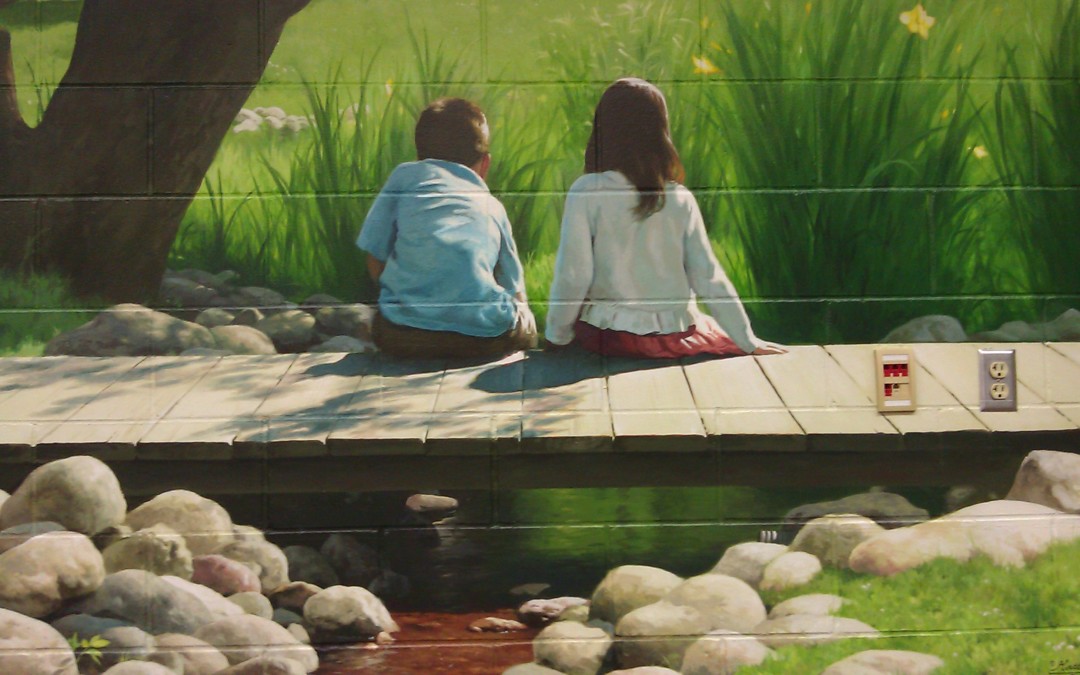
by Matt Philleo | Nov 9, 2015 | Encouraging Thoughts, New Artwork
I want to talk today about taking time to enjoy the scenery around you.
How often are our minds actually present when we’re doing something? We usually think about the next place we have to go, the next meeting we have, the next person we need to meet, the next thing on our schedule, but how often do we actually interact with with what we’re doing at the time?
This is a painting I did–a mural for the Montessori School District in Eau Claire in their IMC, their library. They asked me to paint a picture of these kids sitting on a bridge at the Rod and Gun park here in Eau Claire, and you can see they’re just enjoying themselves, their legs dangling over the edge, as they just look into the river and just take in the scenery and enjoy being with each other and being in nature.
The boy is scooping his hand down in the water, trying to grab a frog, or touch a rock, or pick up some slimy piece of moss–but whatever this boy is doing–he’s just having a good old time.
He’s not worried about what’s going to be going on in the day– if he has any cares at all, he’s totally forgotten them, just sitting there looking at the scenery taking it in.
And I have to say I’m probably preaching to myself here… how many times do I sit at home when I should be totally engaging with my kids, spending time with them? Instead, I just work on something on the side–a project on the computer, something I think needs to get done. It’s seems so important, but it’s not nearly as important as spending time with my kids.

Montessori School IMC wall before mural
I think this is the American phenomenon…this phenomenon of being overworked, over-stimulated with technology–just having too many distractions that take our focus off of things that matter most in life which is relationships with people, relationships with with God. We try to multitask and do too many things at once.
And now I have to be totally transparent here: I am actually dictating this blog post, because I am working on a project that has a tight deadline and I am literally speaking this and transcribing this on my phone as I’m here sketching and working on this drawing that has to be done by tomorrow.
Fortunately, artwork for me is a right brain activity so I can literally draw or paint and talk and carry on a decent conversation all at the same time. Throwing in chewing gum with that I might not be able to handle it!
On the flip side, even though I have this super tight deadline; (at the time of creating this post) this drawing that has to be done by tomorrow– I still plan on going out to dinner tonight with my family to a mutual friends place, because I know that is that’s very important. I could justify it and say I have to get this done and, you know, I just have to get finished because it’s a tight deadline. But it’s much more important to put people and relationships first.
And you know, I can burn the midnight oil tonight.
That won’t kill me to do that for one night.
And when I get there and I’m enjoying that dinner I am NOT going to worry about getting this deadline done. I know it’s going to get done. But I’m just going to enjoy myself at that dinner and enjoy being with the people that all I’ll be with.
Now just to tell you a little bit more about the mural project–that took me about 2 months out of the summer I started it in the mid in mid June and got it done August 1st. But anyway, I had some challenges while working on the mural. Putting up the base coats didn’t turn out quite as I expected.

“Be There:” Mural, 8′ x 34′, Acrylic on masonry, located at Montessori School, Eau Claire, WI, by Matt Philleo, in progress
You know when you get your paint can mixed at the store and the color swatch on on the can looks a certain way but then when you actually put it up on the wall, it looks totally different than what you expected? Well that’s what happened to me–my base coat ended up being just a just a few shades off from what I wanted it to be– well, more like several shades off, and I found myself wanting to skip past that stage of where I was at– the in between stage of not looking so good.
I found myself not quite enjoying the process as much as I could have. But there were a few points where things really took off and I was really just enjoying being there and just painting the image and watching it come together, getting kind of involved in my technique. And eventually it did all come together at the end.
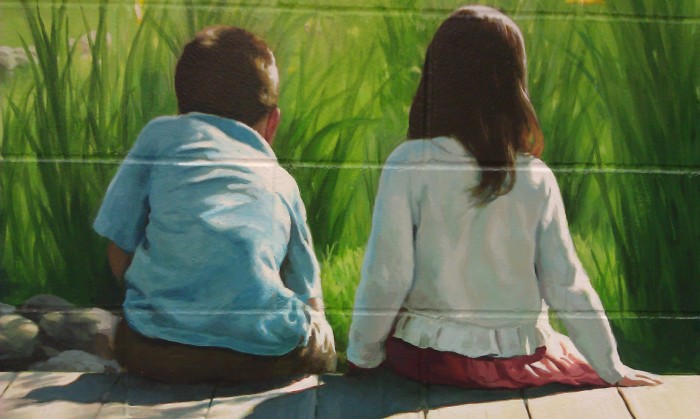
“Be There:” Mural, 8′ x 34′, Acrylic on masonry, located at Montessori School, Eau Claire, WI, by artist Matt Philleo, detail
So I guess the point I’m trying to make is this…
Wherever you’re at, just enjoy being there.
If you’re at work, find a way to enjoy being at work, to do your best job for your employer. I mean he’s paying you after all, so be there. Do an excellent job. And if you’re in nature and you’re you’re outside hunting camping or hiking, shut off your iPhone for a little bit.Just take in the scenery, enjoy it, because by shutting everything off you’re going to have a chance to be recharged in a way that you otherwise couldn’t, having that technology running. If you’re home then be home and spend time with your family. Get to know them, engage with them, love on them, because at the end of it you’ll never regret that time you spend with your family.
Wherever you’re at, be there.
I think Jesus said this best: I’m going to paraphrase this, but He said, “Don’t worry about tomorrow. You don’t know what a day is going to bring forth. Don’t worry about what you’re going to wear, what you’re going to eat, because your father knows you need those things, and he provides those for you. So don’t worry about tomorrow. Each day has its own trouble to worry about. And then finally Bible says, “cast all your cares upon God because He cares for you.”
Share Your Thoughts!
If you have any comments or questions about this post, please leave me your feedback below! I will personally get back to you. Can you help me spread the word? Please share this post with your family and friends by using the social media links on the left side or below. Thank you!
Just be there!

by Matt Philleo | Sep 25, 2015 | Encouraging Thoughts
I have been a part of a local studio tour, the Falling Leaves Art Studio Tour for five years now. The tour is like the classic Sunday afternoon drive, only you get to visit local artists in their studio, see their incredible art, and in between the stops, take in beautiful scenery adorned by the rich fall foliage that we are so blessed with in Northern Wisconsin.
In the tour, there is all kinds of art to see–painting, drawing, pottery, jewelry, functional silverware, woodworking, alpaca yarn creations, and other things you wouldn’t normally associate with art.
I happen to do painting and drawing. But I hook up with an artist,
Ron La Blanc, who does functional and handsome pottery work and colorful landscape paintings as well. In fact, I stay at his home, and take up residence for two days in his garage, which is transformed into my gallery space.
It’s a little challenging, because the side of garage I use is actually where he stores his wood to get him through the winter. (Well, he stores enough to get him through about 5 winters!) Over the last few years, I’ve gotten a little better each time at converting a wall of irregular wood into a gallery space. You hammer nails into the logs, pivot the framed artwork against the various pieces, and pray that they don’t fall!
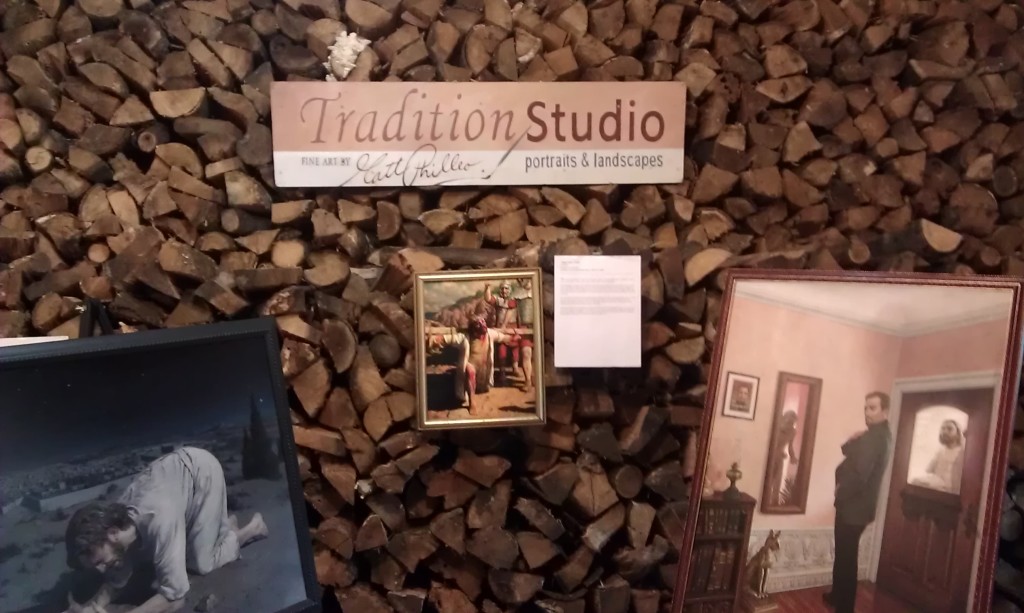
Matt Philleos gallery space at the Falling Leaves Art Studio Tour
Some of the tour goers have said the wood wall makes a unique backdrop. I agree.
I really enjoy getting into meaningful conversations with some of the visitors. A couple years ago, a lady looked at one of my paintings, and just cried. She had been going through a really rough time in her life–if I remember correctly–with health issues, and God encouraged her through my artwork. She said “this is the whole reason I came out to the tour today.”
Along the way, I sell a few pieces of art too, which is nice. I also have gotten some commissions for paintings through the tour.
Maybe the best part of the tour is enjoying the warm hospitality of the La Blanc family. They are generous, loving people that put you at ease right away. And man, can they cook! After the first tour day is over, they have a large meal with their extended family at a giant table fit for a king. And they treat me like part of the family.
I am looking forward to seeing everyone at the tour this year. I want to extend a personal invitation for you to come out too this year, if you haven’t already made plans to do so. The tour is Saturday October 3, from 10am-6pm, and Sunday October 4, from 10am-5pm.

by Matt Philleo | Sep 15, 2015 | Christianity & Culture, Encouraging Thoughts, New Artwork
From the day we are old enough to crawl and grab for something, it’s obvious we have a constant desire for more. Our older brother has a toy and we want it, just because he has it. We grow up and go to the mall. Then we want the toy on Black Friday that everyone else is pushing and shoving to get.
Our neighbor has a new car. We were happy with our car a moment ago until we saw what she has. Now we want it. it is hard to be content today in this world. We have TV, newspaper, billboard and internet ads telling us we’re missing out and have a major problem unless we have the latest product they’re selling.
And when we buy something new, it captures our attention. We feel great with our new purchase, we can’t wait to try it out–or on–and then after a couple weeks or even less, the newness wears off. And off we go to something else that glitters and captures our interest once again. This cycle of discontent–acquiring–fascination–apathy–discontent continues on and on for our whole life, consuming everything good, ravaging relationships, until we look back in regret on the wreckage of our lives. By that time, it’s often far too late to do anything about it.
How can we be content?
All of us–unless we have major issues–want to better ourselves. We want to provide a decent living for ourselves and our family. We want to have something to share with others. We want to contribute value to our society. There is a struggle in working to provide those things. We see others who have succeeded and often feel jealous.
That’s the problem. It’s when we want what others have–that’s where we go astray. Instead, we should want what the God who created us wants us to have. He knows what is best for us. It may be that He wants us to be incredibly, coin-dropping wealthy. But He may also want us to be poor–at least if only for a season. And when I say poor–I’m not talking about being impoverished where you are homeless, starving, in danger of dying in the cold. I mean just living a clean, humble, hard-working, honorable life where perhaps your accommodations and possessions are less than what you’d like.
The Bible says, “Godliness with contentment is great gain.” We also learn from the Bible that we didn’t bring anything into this world and we definitely aren’t going take anything out of it either. So let’s be content with what we have, because God has promised to provide for us.
Maybe you’re thinking, “that sounds all well and good, but how can I be content when I live paycheck to paycheck and just barely get by?
Let’s put our lives into perspective.
If you live in America, as I do, even if you are dirt poor, you have a higher standard of living than over 90% of the world’s population. Consider this:
If you are homeless, there are shelters in nearly every major city.
If you have a home but struggle with putting food on the table, there are welfare programs and food pantries to help.
You have access to sanitary drinking water and have indoor plumbing where you can daily take a bath, wash your clothes, and remove your waste far from your home.
You have electricity to power a myriad of equipment, conveniently taking care of many household tasks that would have been the envy of the richest of us 100 years ago.
When it is steaming hot in the summertime, you have an air conditioning unit or at least a fan or two to cool off.
When it’s cold in the winter, you have heat and some sweaters or jackets to put on if it’s a little chilly.
You can get in your SUV and brave the roads, of course, after you neatly cleared off your driveway with a snowblower.
I don’t need to go into all the other gadgets we have to entertain and make our lives easier, such as laptops, smartphones, video game systems, etc. We have what we need for subsistence living and stuff on top of that to boot.
So here’s the deal. If we have food and clothing, we ought to be content with that.
Anything more than that is bonus. But still–why is it so hard to be content?
Being content starts on the inside. People can find something close to it when they get rid of their stuff and live a simpler, minimalized life. But true contentment only comes from the God who created us. When we believe in His word– the Bible–His peace that passes all understanding guards our hearts and minds (from the worries, cares, and competitiveness of this world) in Jesus Christ. First, we have a peace or contentment that comes from having a right relationship with God. That is accomplished through recognizing our sinfulness and trusting in the finished work of Jesus Christ (His death on the cross, burial, and resurrection) to make our consciences clean before God. Secondly, this contentment continues as we grow in our relationship with God and our perspective on life changes.
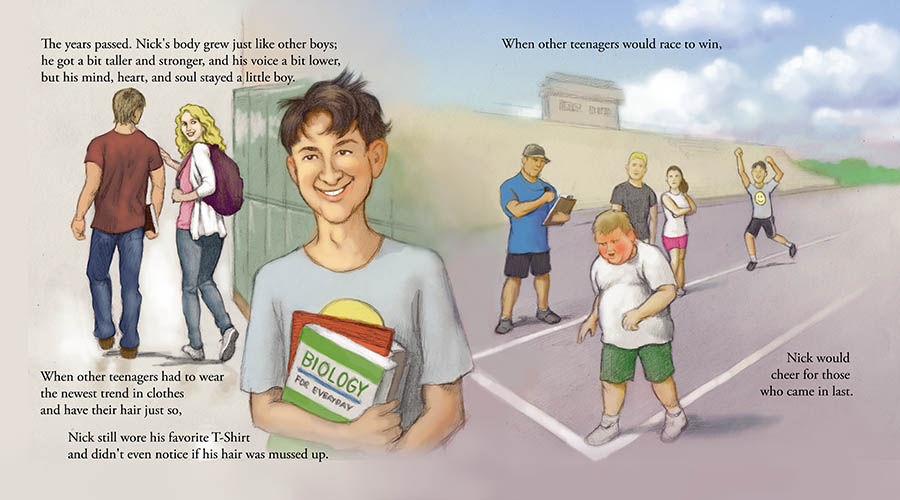
“The Boy in a Tree,” pages 11-12
To be content, you have to be happy being who you’re created to be, without comparing yourself to another.
This state of contentment comes from knowing God loves you, and He has everything you need within Himself to make you happy. Your world may be crumbling all around you. But you don’t bury your head in the sand and ignore reality. You instead reach out and into God, drawing strength from the fact that He loves you and won’t give you more than you can handle. You stand on the truth that He is more than capable to guide you through the storm and get you to safety. When you get a vision of the glory, the awesomeness of God, your problems dwindle in size by comparison. Now you’ve got the right perspective. Your problems may not have changed. But your attitude toward them has. This allows you then to come up with a better solution.
Oh, and guess what? Now when you get a hold of God, not only has your attitude towards your problem changed–He can work on your behalf. He often will do something amazing to help you out in your problems. I’m saying you will see something more than you doing something to get yourself out of a pickle, and humbly saying “God helped me.” You will actually witness a miracle apart from yourself that you can only attribute to God.
At other times, in the sovereignty of God, you may remain in a difficult situation for months or even years. That’s okay. As hard as that situation is, when you feast on the goodness of God, that trial seems like an annoying mosquito you can swat away. Your trust in God grows accordingly, and that in itself is a blessing.
Here are a few more pages of the children’s book by Pam Boodle I illustrated, “The Boy in a Tree.” Nick, a child cognitive disabilities, is a boy who grows up yet his mind remains as a young child’s. In many ways, this is his greatest asset. Being content comes naturally to him.
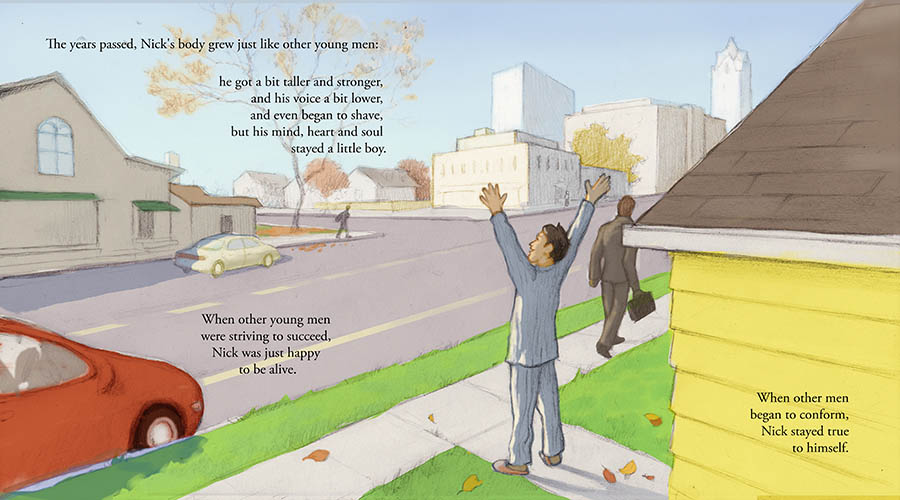
“The Boy in a Tree,” pages 17-18.
You can stir up a spirit of contentment by choosing to be thankful. Sometimes thanksgiving will rise up within you like bubbles to the top of champagne when you receive an unexpected blessing, but most of the time you have to actually take stock of all the good things you have and thank God for them. If you remember that old hymn “Count your blessings, name them one by one…”
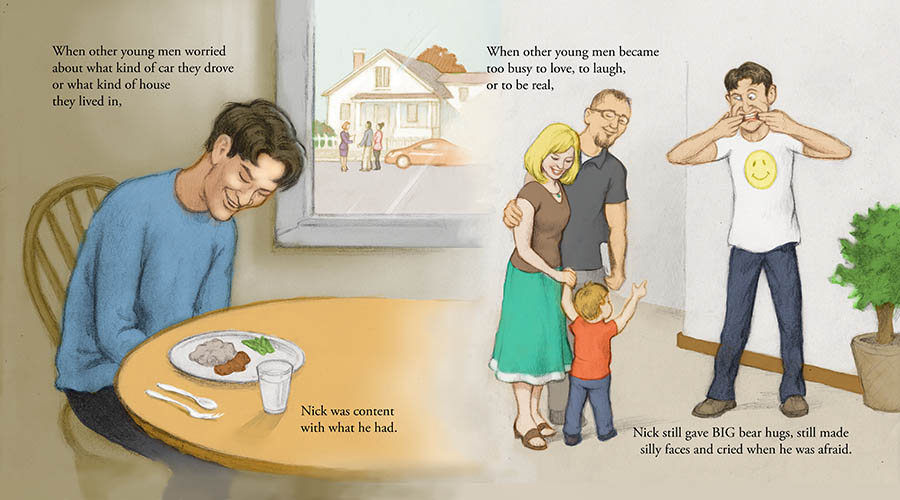
“The Boy in a Tree,” pages 19-20.
I have a habit of praying for my food, but I have to admit, a lot of times it becomes a lifeless ritual. I’m not actually thinking about how good God has been to me when I mumble the words. I just want to dig into that juicy burger! But sometimes, I’ve just dropped to my knees (when I was eating alone) and realized how blessed I am to eat the kind of food I have access to when others in the world have gone days without anything.
A life lived in contentment is a life without regret.
If we are content, we will pursue the right things–relationships for the benefit of helping others. If we are discontent, we will pursue the wrong things–relationships for the benefit of acquiring things: money, possessions, power, and fame. We are so blessed in this nation, even now, with a shaky economy. Let’s stop and give God thanks for all He has done for us. Let’s be happy being us, and watch God make us better as we live in a spirit of contentment.
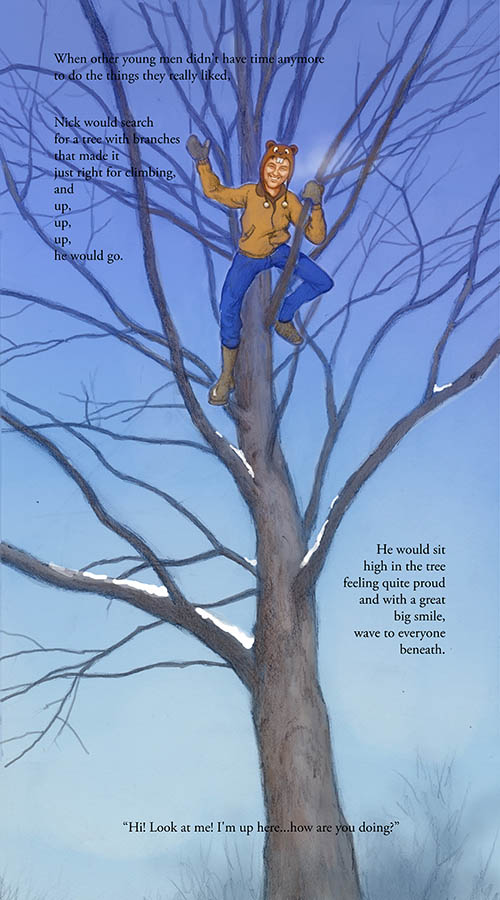
“The Boy in a Tree” pages 21-22.
Share Your Thoughts!
I’d love to hear your comments, questions, thoughts, and ideas. I will personally respond to any comments you leave. If you like this post, please share it with a friend by using the social media links on the left sidebar. Thank you!

by Matt Philleo | Sep 10, 2015 | Christianity & Culture, Encouraging Thoughts
The recent malaise in Rowan County, Kentucky with the defiant County clerk Kim Davis is a signpost signaling a new era in the culture of America. Biblical, traditional family values are out; unorthodox, non-traditional values are the new normal.
I’ve been following the news on Kim Davis very closely. (Maybe a little too closely!) If you aren’t aware by now, she is the Kentucky county clerk who dared to defy the recent ruling by the Supreme Court legalizing same-sex marriage, and then was jailed for it. She has put a name and a face to the incendiary cultural clash of traditional Judeo-Christian values and post-modern secular atheism. Never before in America has a government worker been jailed for simply following their Christian belief.
After the Court’s ruling in June, I felt like I was watching a football game and my team lost. And when Kim Davis was jailed, that was the dagger! But now, she has been released and it remains to be seen if she will continue in her courageous rejection of an unjust law (which is really no law at all).
I and many Christians around the nation prayed for her to be set free, and that she would strand strong in the face of severe opposition. I’m glad she didn’t give in to the pressure to conform. Somehow though, her release from jail seems like a hollow victory, especially with the strict warnings the judge imposed on her to no longer interfere with the signing of certificates. It feels like we just scored a touchdown, but we’re down 41-10 with 2:00 minutes remaining in the game.
The whole Kim Davis scenario has set a precedent of what will happen if anyone dares to oppose this new intolerant regime by standing up for traditional marriage. And not only the government is caustic towards people like Kim Davis, but if you look at the comments after the news articles and tirades in social media you get the idea that a good majority of Americans would hang her if they could.
In the wake of all of this, many Christians wonder, how should we then live?
Of course, we’ve been hurtling down this path for quite some time now. It has not been a seismic shift. Instead, it has been a gradual decline in morality. But for those of us who hold fast to what the Bible teaches and are old enough to remember an America that upheld traditional common-sense definitions of what constitutes marriage and family, this incident is like a mile-marker delineating how far we have come. How far we have gone off-track. This story burns in our mind as a daunting image of the New Anti-Christian America.
Since America is now clearly opposed to Biblical Christianity, how then shall Christians live? I see four options:
1. If we can’t beat ’em, join ’em.
We can begin to agree with the increasingly immoral culture and accommodate our Christian beliefs to the rapidly changing social norms around us.
We can interpret the Bible according to 21st century American society and make it more relevant to our hearers. After all, we want to be able to fit in enough to share Jesus with those around us, don’t we? Jesus didn’t get mad at anyone or judge anyone, did He?
When we actually read our Bibles, we discover a Jesus who was indignant at sin, although He showed amazing mercy to those trapped in it.
I am amazed at how many Christians (perhaps self-professing) defend the homosexual lifestyle and equate their demand for rights with the civil rights movement of Martin Luther King, Jr. However, homosexuality is a behavior, not an inherent characteristic such as skin color or gender. While homosexuals are often vilified, treated by many Christians as if they were the only sinners worthy of judgment, the behavior is still a sin, because it is a perversion of God’s original design for men and women. But it is also a sin that can be forgiven and a behavior that can be changed by the grace of God.
2. If we can’t join ’em, beat ’em.
We can become militant ourselves, waging a counter-offensive in the culture war and demand that America returns to its Judeo-Christian cultural roots by aggressive political efforts, picketing, petitions, lobbying, calling representatives, even preparing militarily to fight against a possible government subjugation of its citizens. Now I am not saying that we shouldn’t vote or contact our representatives. We are fortunate enough to live in a Constitutional Republic, where we have many rights that are still the envy of the world. With those rights come the responsibility to be involved in the political process of electing leaders that most closely represent our values. However, we are do not wage war as the world does. As the Bible says, our weapons are spiritual.

“Victory in Surrender” 16 x 20, acrylic on canvas, by Matt Philleo.
I don’t think fighting the culture war politically is the way to go.
3. If we can’t join ’em or beat ’em, forget ’em.
We can bury our head in the sand and believe things are not that bad, or will get better with time.
Maybe if we get a Republican president, things will turn around. Not a chance. Remember Roe vs. Wade? Over 40 years later, all we have managed to do–even with several Republican administrations–is enact a few slight restrictions on abortion. But for the most part, that industry is going full steam ahead. We’ve gotten a few hits, but we have definitely not tackled the issue.
4. If we can’t beat ’em, join ’em, or forget ’em, we can…help them!
We can do what Paul the Apostle did: reach out to others in a wicked and pagan culture with the pure, unadulterated, transformative message of the Gospel, one person at a time.
We are not trying to save the culture.
The culture in America is clearly pagan.
President Obama was right: this is not a Christian nation.
In fact, it never was. Rather, in its inception, it was a secular nation that highly esteemed a Judeo-Christian worldview, and accordingly, governmental laws and policies reflected that. But now, America’s worldview, at large, is no longer Christian. That is why the laws and policies passed no longer favor Christians, but instead threaten us. It is easy then, to become reactionary and want to steer our culture back to its godly heritage. It would be good if this happens, but only if indirectly, as a byproduct of reaching people with the good news of Jesus Christ.
Many postmodernists, especially generation Xers and millenials, believe fundamentalist Christians want to take over the government and I don’t think they are completely off the mark in feeling that way. However, Jesus said: “My Kingdom is not of this world.” Our goal should not be to establish a theocracy.
Instead, let’s aspire to do what Paul did. He preached the gospel and people got saved. How many? Probably a relatively small percentage of the Western world’s population. But the fact is, souls were saved. In the same way, Peter the Apostle urged his fellow Jewish countrymen, “Be saved out of this wicked and perverse generation.” Recently, the associate pastor at my church wisely remarked in one of his sermons that “we should not curse the darkness but rather light a candle in it.” I wholeheartedly agree. And the darker the darkness, the brighter the light shines by contrast. The thrust of our efforts should not be trying to save the culture, but to save people out of the culture.
So, do we stand up for the traditional view of marriage? Yes, absolutely! The best way we can do that as Christians is to live in such a way that we are above reproach. In other words, we want the world to see that we are different, and the difference maker is Jesus. Our marriages and families should be rock solid, a visible testimony of the solid Rock, our Lord Jesus Christ. Then when we speak to others about Christ, we will actually have something to say, not just the usual Christian rhetoric that only confirms the world’s perception of us as hypocrites.
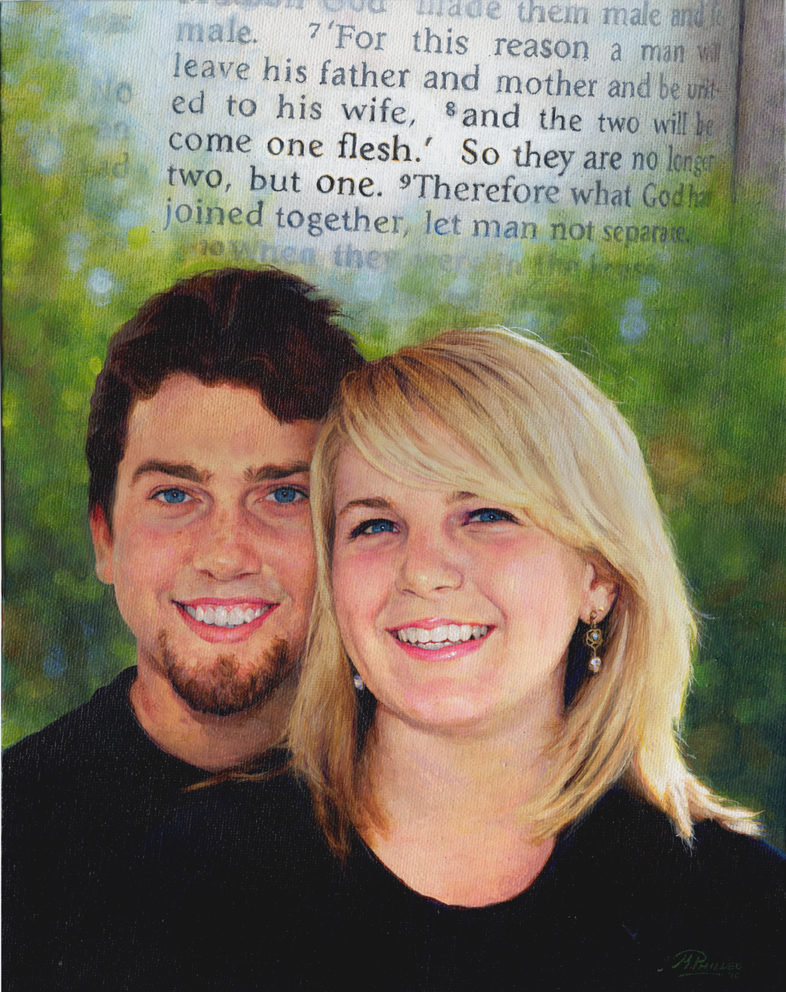
Ben and Amber Portrait 11 x 14, acrylic on canvas
Should we give up on the idea of America turning around? No, of course not! This is a nation of people. And people can repent and turn to God. So if Christians got serious about their faith, repented of their sins and many unbelievers were born again, certainly we’d have a revival on our hands. It has happened before in our nation’s history in the late 1700’s and it could happen again. In fact, we should be praying that it will. God does not want anyone to perish, but wants all to repent.
The illustration shown at the top of the post is a painting I did for a baby gate manufacturer. They wanted an illustration that shows a happy family from 1950’s era. The beaming young parents joyfully watch their baby playing on the carpet in front of them, the perfect image of domestic happiness. While I understand that there may be more myth than reality to this “Leave it to Beaver” and “Father Knows Best” generation, there certainly was a more positive view of the traditional family during that time. A family consisting of two loving parents, husband and wife, is no longer the norm. Broken homes, fractured marriages, and strange relationships now called marriages is the new reality.
This culture war will not be won with clenched fists, loud mouths, and fast feet. It will be won with open hands, listening ears, and bent knees. Let us serve others with our hands, so everyone will see the love of Christ in us. Let us listen to others’ stories, truly care about them so that we can share the gospel with a receptive heart. And most importantly, let us pray that God would be glorified by what we say and do as He uses us to rescue lost and dying people out of a wicked culture.
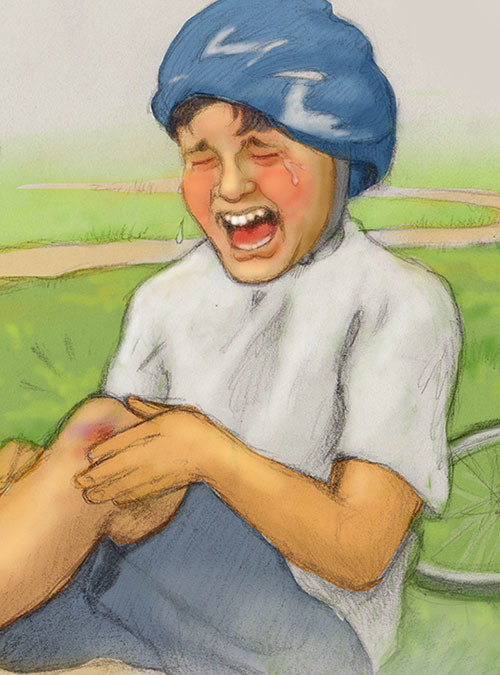
by Matt Philleo | Aug 29, 2015 | Christianity & Culture, Encouraging Thoughts, New Artwork, Personal Inspiring Stories
“Quit your crying!”
From the time we were little children, most of our parents told us not to cry when we were hurt. Even if our moms and dads were of the more nurturing nature, the message that is crying is for wimps was reinforced by our classmates, heroes on TV, and society’s expectation in general.
Of course, there is a time to stop crying, deal with your problem and move on, just as my wife and I tell our children.
But how many of us are holding back tears during a time when we should let them flow? We may experience an extreme trial such as a job loss, the severing of a close relationship, abuse toward us or those we love, accidents, bad news of a serious illness, or even a death–and because we were taught to hold back the tears, buck up, and save face–we stuff the feelings of grief and emotional trauma deep down where we think it’s hidden for good.
But it has a way of coming back.
In anger, frustration, bitterness, despondency–we often lash out toward those who are closest to us and could console us.
We hide behind a wall, a veneer of togetherness, when inside we are falling apart.
In this post, I am showing pages 7-10 of the children’s book I recently illustrated, “The Boy in a Tree,” by Pamela Boodle. (If you missed my first post introducing this book, you can check it out right here.)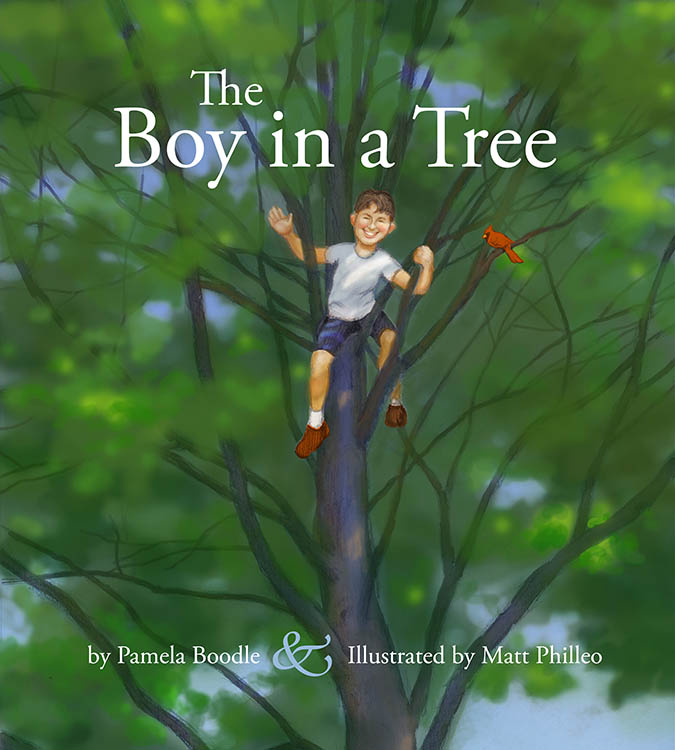
In the book, Nick, a cognitively impaired child, sees the world in a different way than most of us. Although he may not be able to do many of the things we take for granted… …His slower pace naturally allows him to notice the more important things in life that really matter.
And because he is not socially adept enough to hide behind a facade of respectability, he goes around living life by…just being himself. He doesn’t care how he looks to others. When he’s happy, he’s not too “cool” to show it. When he’s hurt, he doesn’t hold back the tears. And because of this, he is more emotionally healthy than many “typical” people.
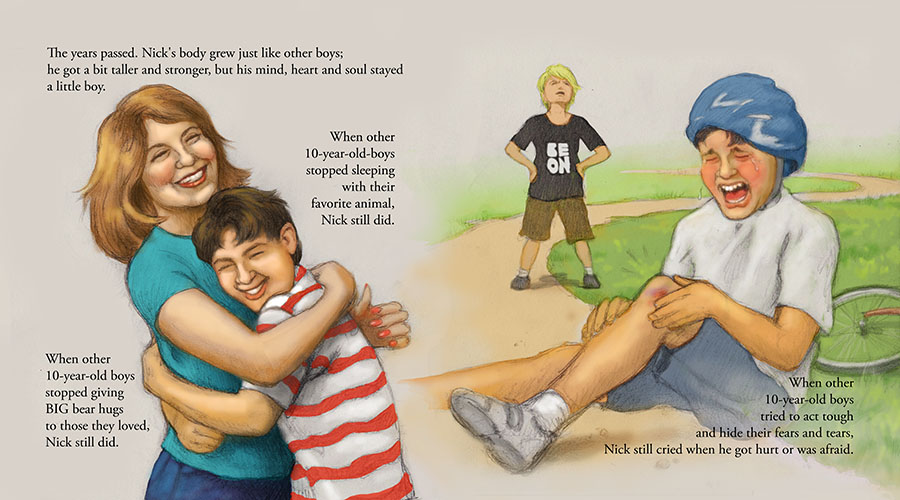
“The Boy in a Tree,” pages 7 & 8

“The Boy in a Tree,” pages 9 & 10
My dad died from brain cancer in 2010 at the age of 64. He and my mother divorced 11 years prior to that and I hadn’t been very close to him up until that point, especially since he moved to another state. But after learning of the tumor, my family and I visited him several times.
We saw the progression of the disease and how it reduced him from a confident, articulate, intellectual man to a blind, nearly helpless child, who needed assistance going to the bathroom. Unlike many people who are suffering from cancer, he was not bitter or despondent. He was very thankful whenever anybody did anything for him. All he wanted to do at the end was snuggle with his children. So, putting pride and awkwardness aside, I snuggled up next to my dad, and after a while he began to rub my belly. This seemed strange at first, but then I thought that this was maybe what he might have done when I was a young boy, and that somehow this might have brought him comfort, a feeling of closeness to his son.
I cried.
I prayed for him that God would heal him. I wanted him to stay alive so he could see and hold his grandchildren, and watch them grow up.
But about a month later, he died. When I got the news on the phone from his wife (who took care of him so selflessly, by the way) I didn’t feel anything. I expected to feel grief and wondered if something was wrong with me. Then I remembered how I cried so deeply during our last visit and, although I didn’t know it at the time, I realized I already grieved his death. I didn’t feel remorse. I was glad we drew close at the end and had no regrets.
About a year later, an older man in our church died. He was the head usher, a kind and gentle man that everybody seemed to love. At his funeral I grieved his death with many tears. Although I knew he was in heaven with the Lord, I missed his fellowship.
In Christian circles, we often chide people for grieving at a funeral.
Because we have such a great hope of seeing our departed loved ones in heaven, we religiously expect a stoic response–hypocritically renamed as “joy”–during a time when we should be the most vulnerable and open with our feelings.
But in the Bible, you will see a completely different response.
For example, when Lazarus died, what did Jesus do? He wept. (John 11:35) When Stephen, the first martyr of the Christian church died, what did people do? “Godly men buried Stephen and mourned deeply for him.” (Acts 8:2) When Tabitha died, what did the Christian church do? Did they say, “Hallelujah, Tabby’s risen to glory!” No! “All the widows stood around him (Peter), crying and showing him the robes and other clothing that Dorcas (Tabitha) had made while she was still with them.” (Acts 9:39)
Do you remember Samuel? Even if you don’t know the Bible very well, the name is so well known today because of a famous Jewish prophet who lived 3,000 years ago. I don’t think it is stretching the truth to say that there would be no Samuel unless a woman wasn’t afraid to cry. His mother, Hannah, couldn’t have any children. And in the Jewish culture, a woman being unable to have a child was the worst possible shame to endure. So what did Hannah do?
She cried out to God. Literally.
In the first book of Samuel, we read in verses 10-11:
“In her deep anguish Hannah prayed to the Lord, weeping bitterly. And she made a vow, saying, “Lord Almighty, if you will only look on your servant’s misery and remember me, and not forget your servant but give her a son, then I will give him to the Lord for all the days of his life…”
And then in verse 20, it tells us God answered her prayer.
“So in the course of time Hannah became pregnant and gave birth to a son. She named him Samuel, saying, “Because I asked the Lord for him.” Samuel turned out to be a God-following man, the prophet who would anoint King Saul and King David, one of Israel’s greatest prophets of all time. But his life came as a result of a broken person who wasn’t afraid to show her brokenness.
Hannah didn’t pretend to be happy or, on the flip side, resign herself to misery. She owned her pain, and cried out for relief.
And that’s exactly what she got.
When we grieve, it’s like showing our wound to someone who can help us, instead of letting it fester and get infected. If we are real with God, others, and ourself, and say “This is my pain, I’m not hiding it. God please help me through this! Deliver me!” Our loving Lord will come and salve our wound, and healing will come. In time, we will experience true joy–not a forced smile that looks like Joker’s face–but a true, abiding, pervasive joy that comes straight from God, settles down into the deepest part of our being, and then bubbles up and flows out of us like a fresh spring of water!
QUESTIONS TO PONDER:
1. Is there any pain from the past that you have hidden and could deal with now?
2. How can you show compassion to someone who is hurting and help ease their pain?
3. Do you know what it is like to feel true joy in during incredible sorrow or difficulties?
Share your thoughts!























Recent Comments